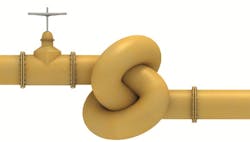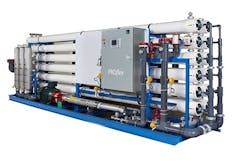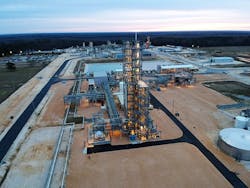Wastewater Technology: Developments Decrease Discharges
Demand for zero liquid discharge (ZLD) and near-ZLD projects is evolving as chemical companies look for more-tailored technologies that not only meet regulatory requirements but also generate greater economic benefits, reports Bill Heins, global leader, new market development for Suez Water Technologies & Solutions, Bellevue, Wash.
“The biggest change is in technology. In near-ZLD projects, a lot of what we do depends on the specific contaminants contained in the wastewater being treated. We look to carry out as much pre-treatment as possible during the membrane step because this minimizes the size of crystallizers and evaporators needed downstream. So, there are savings on operating cost and space,” he explains.
The ZLD pre-treatment step itself now makes use of new membrane-element and system designs that operate at higher water recoveries and, thus, provide greater cost effectiveness on tough-to-treat wastewaters containing a complex blend of contaminants.
In certain circumstances, where somewhat lower permeate quality is acceptable, for example, the membranes themselves can be designed to be “looser.”
“The trade-off here is between higher flux and higher rejection. In these circumstances, we can optimize the process with, for example, low energy membranes where a higher total dissolved solids (TDS) permeate is acceptable. In other cases, higher recovery is the objective, and we can achieve recovery from 75–95%,” Heins adds.
Using a looser RO membrane permits passage of monovalent salts such as silica and sodium chloride. Such a membrane gives high recoveries without needing a concentration step and, thus, avoids issues related to high osmotic pressure or precipitation due to high concentration.
However, when concentrating salt at high recoveries — a common requirement — osmotic pressure often is the limiting factor. Here, ultra-high-pressure membranes allow operation at higher pressures, in turn, enabling much higher salt concentration while still producing a reverse osmosis (RO) permeate.
High temperature RO remains an important area of interest for Suez, which is working with both universities and customers to develop innovative designs. These include, for example, new membrane elements that can operate at higher temperatures, different module designs, and alternative materials of construction, including glues, that can withstand higher temperatures.
“A lot of this development is being carried out in our labs and those of our partners, and in a field demonstration-scale plant for applications such as brine processing,” says Heins.
The challenges are both physical and chemical, he notes.
On the physical side, there is the need to source commercially available materials that meet the design and cost requirements of an RO membrane element that will perform when operated at high temperature and normal operating pressures. Chemically, there is RO performance. As temperature increases, so does RO flux; thus, the design of the system must take this into account to balance the average flux throughout the membrane system.
Figure 1 Membrane systems such as PROflex can concentrate organic contaminants in a waste stream. Source: Suez Water Technologies & Solutions.
In certain circumstances, membrane processes can concentrate organic contaminants of concern to minimize the volume of the waste stream (Figure 1). This concentrated waste then can undergo further treatment to destroy these contaminants or to capture them — using ion exchange (IX), activated carbon adsorption or similar processes — for subsequent disposal, or be disposed of directly if allowed by regulation. “In some circumstances, the contaminants can be recovered and reused in the process,” Heins explains.
Recovery From Waste
As an example of this, he cites an ongoing project at a manufacturing facility with a large sodium-sulfate waste stream that is considering using ZLD to precipitate and dispose of the waste. One technology being developed with the customer relies on bipolar electrodialysis to eliminate the waste stream and, instead, recover and reuse valuable sodium hydroxide and sulfuric acid. This would yield an economic benefit to the customer, decrease overall carbon footprint, and greatly reduce the need to purchase and transport chemicals to the site.
“These types of solutions, where we can eliminate waste, recover a useful product, improve economics, and reduce carbon footprints are the holistic solutions we are developing much more today,” he stresses.
Integrating pre- or post-treatment steps may make sense, counsels Heins. Depending on the chemistry involved in the ZLD process, possible upstream technologies include IE, nanofiltration (NF) and RO while, downstream, IE or RO and electrodeionization (EDI) may boost polishing. “This is especially important if we are trying to minimize the size of ZLD systems while at the same time maintaining process operability. It’s really bringing optimization to customers based on their project-specific needs. One example here is using clarification/softening and RO preconcentration upstream of a ZLD system and then RO/EDI for permeate and distillate polishing for use as boiler feedwater.”
Don’t underestimate the importance of process control, for example in scale management, Heins cautions. Here, the challenge is to avoid irreversible scaling or the fouling of membranes. Process control can help mitigate these problems by cycling between high and low TDS levels to disrupt scale formation.
“Digital monitoring is used to predict issues prior to their occurrence, reducing downtime and minimizing operating costs. Many of our sites utilize this type of remote data monitoring,” he adds.
He also points to the recent trend of companies in disparate industries coming together to solve common problems, citing various green hydrogen projects around the world. “There are lots of synergies,” Heins concludes.
Pursing Environmental Goals
At Chemours, Wilmington, Del., 2030 Corporate Responsibility Commitment (CRC) goals commit the company to reducing air and water process emissions of fluorinated organic chemicals (FOCs) by 99% or more.
“Reduced discharge approaches are one avenue we’re pursuing to meet this CRC goal and improve our water management practices,” notes Steven Grise, an engineering fellow with Chemours.
The company’s Fayetteville manufacturing site in North Carolina (Figure 2) is at the forefront of FOC emission-reduction efforts, most recently with the implementation of a new pilot treatment plant.
Figure 2. North Carolina plant is at forefront of company’s efforts to reduce emissions of fluorinated organic chemicals. Source: Chemours.
Grise outlines the overall challenge: “Products at our Fayetteville site are produced in batches or campaigns which presents treatment challenges for the aqueous effluent as there are changes in its composition. In addition to the normal process challenges, we must also consider equipment cleaning for the production changeover, plus point sources such as pump seal flushes. To add further complication, multiple sources of compounds come from various parts of the process and numerous collection points such as sumps, scrubbers, and trenches.”
For the pilot system, the first step was separating non-contact water from the contaminated process water.
“Segmenting these water flows was worth the effort — and investment — as it resulted in lower volumes of effluent that required treatment,” states Grise.
Next, the company segregated and redirected streams to create distinct water and air streams for mitigation. Removal of gas-phase emissions left a complex mixture of aqueous FOCs and contaminants from multiple sources.
Chemours determined that an additional segregation step was necessary to separate high TDS/high total organic carbon (TOC) flows from streams with more-moderate FOCs concentrations and lower TDS levels.
“Significant effort was required to redirect the streams to two separate sets of tanks, resulting in water solutions of different compositions. The composition of one tank was amenable to RO technology for treatment with a series of bag and cartridge filtration units for suspended solids removal,” Grise explains.
The RO treatment train uses spiral-wound membrane elements designed for high pressure and high salt rejection. High pressure allows the first pass to concentrate both FOCs and other associated salts and material in the plant water. The high salt rejection results in a small-enough membrane effective pore size to reject a very high percentage of FOCs.
The second-pass RO membrane provides additional polishing of FOCs. The concentrate from the second-pass RO treatment is recycled to the feed water for the first-pass RO system. The final step is to polish the second-pass permeate with granular activated carbon (GAC) and a mixed-bed deionization resin.
“Efficiency testing of the pilot treatment system showed that FOCs are removed with an RO efficiency of greater than 99%. Water recovery varies because the inflow TDS varies but generally runs in the 65–75% range,” reports Grise.
“An important characteristic of the RO/GAC/IE effluent is that the produced water is of near-demineralized quality. While this quality water is not acceptable for some ISBL [inside battery limits] applications, it is recyclable as a clean water source for many areas on the Fayetteville works site. This is an ideal result for the sustainable operation of an industrial manufacturer,” Grise emphasizes.
The 2030 CRC goal to reduce process emissions of FOCs and associated work to continually improve water management practices mainly will drive Chemours’ adoption of minimal liquid discharge (MLD) and ZLD approaches, he says.
“When looking at the industry’s adoption, there are major challenges in the drive to ZLD. One real-world challenge relates to a scenario whether 100% of the water used in a process can be recycled. In certain plant designs, rainwater intrusion may be inevitable and tip the balance of what can be reused to a point where some limited amount of liquid discharge will be necessary. A second challenge relates to managing the remaining solid residue after ZLD is achieved, as companies will be challenged to find ways to recycle or utilize those solids within their processes,” Grise cautions.
Figure 3. Unit will play a key role in Norwegian ammonia producer’s decarbonization efforts. Source: ITM Power.
Like Heins, he is looking to the synergies created by green hydrogen and fuel cells via water electrolysis.
Last August, as part of its commitment to enabling the transition to a global hydrogen economy, Chemours joined the leading European fuel cell and hydrogen technology association, Hydrogen Europe, Geneva, Switzerland.
The Promise Of PEMs
“This opens doors for Chemours to collaborate and contribute to solutions that positively impact the global community and drive the movement to establish hydrogen as a preferred solution in clean energy,” explains Grise, adding that membership will give the company the opportunity to apply its Nafion proton exchange membranes (PEMs) to a broader base of applications.
An announcement at the end of January by Linde Engineering, Pullach, Germany, further highlights the growing significance of PEMs. The company will construct and deliver a 24-MW green hydrogen plant for fertilizer manufacturer Yara, Oslo, Norway. PEMs will be at the heart of the electrolyzer in that plant, destined for Yara’s site in Porsgrunn, Norway.
Using power from renewable sources, the electrolyzer will have a capacity of around 10,000 kg/d of hydrogen. Its output will partially replace the grey hydrogen currently used at Yara’s Porsgrunn ammonia plant. This, in turn, will remove 41,000 t/y of carbon dioxide emissions from that plant.
The electrolyzer itself (Figure 3), which comes from ITM Power, Sheffield, U.K., will produce enough hydrogen to create 20,500 t/y of ammonia. This then will be converted to between 60,000 and 80,000 t/y of green fertilizer. It will mark Yara’s first step toward decarbonization of its ammonia production.
The company’s first green ammonia products are expected to hit the market by mid-2023.
Seán Ottewell is Chemical Processing's editor at large. You can email him at [email protected].




